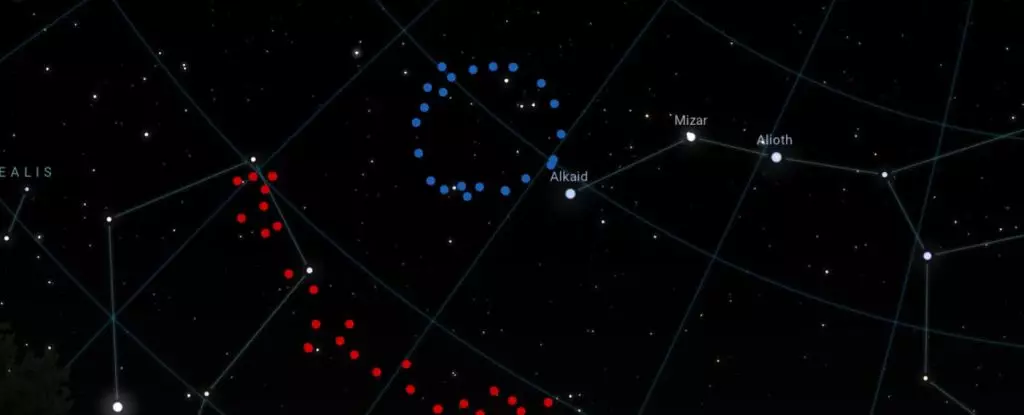The Universe continues to surprise us with its breathtaking complexity and size. Recent astronomical findings have unveiled a structure that challenges long-held beliefs about the nature and evolution of our cosmos. Known simply as the “Big Ring,” this colossal formation consists of an almost perfect ring of galaxies spanning a staggering 1.3 billion light-years in diameter. Such monumental discoveries not only stoke the fires of curiosity but also compel us to rethink the foundational principles of cosmology.
Led by the astute astronomer Alexia Lopez from the University of Central Lancashire, the Big Ring’s discovery was shared at the 243rd gathering of the American Astronomical Society and subsequently published in the Journal of Cosmology and Astroparticle Physics in early 2024. This breakthrough adds to Lopez’s prior work involving the Giant Arc, another massive structure identified in the same region of the sky just a few years earlier. Both formations perplexed astronomers upon their discovery, forcing us to confront the limitations of our current cosmological frameworks.
The Challenge to Established Cosmology
What makes the Big Ring especially intriguing is its deviation from previously accepted models of cosmic structure formation. Traditional cosmology operates under the assumption that galaxies are distributed uniformly across vast distances. However, Lopez emphasizes that the existence of structures such as the Big Ring and the Giant Arc prompts a re-evaluation of the Cosmological Principle, which posits that any large enough section of the Universe should display homogeneity.
According to Lopez, current theoretical models suggest a maximum size for cosmic structures of approximately 1.2 billion light-years—an estimation the Big Ring significantly overshoots. This disparity raises a profound question: if the standard cosmological model cannot adequately account for these formations, then what are the implications for our understanding of the Universe? The phenomenon challenges both our grasp of the landscape of cosmic structures and our presumed limits in cosmological theory.
Possible Explanations for the Big Ring
While the discovery opens up exciting avenues for research, it also leaves us with many unanswered questions. Lopez and her colleagues have speculated about several theories that might explain the Big Ring’s existence. One possibility is a previously unsupported variation of Baryon Acoustic Oscillations (BAOs). While BAOs represent remnants of early acoustic waves in the Universe, the Big Ring does not conform to these known patterns. Instead, examinations show it as a corkscrew-like structure—far from the spherical formations that BAOs typically create.
Another provocative hypothesis suggests the Big Ring might be a type of topological defect known as a cosmic string. These string-like structures could represent the remnants of the primitive Universe, growing like wrinkles in the fabric of space-time. Although convincing evidence for cosmic strings is scarce, their theoretical framework offers a glimpse into how foundational elements of our Universe might behave at large scales.
The Road Ahead: New Frontiers of Astronomy
The bewildering scale and form of the Big Ring serve as a reminder of how much remains to be understood about the Universe. As we delve deeper into these cosmic puzzles, the possibility arises that more structures similar to the Big Ring could exist, camouflaged among the vast celestial tapestry of our observable Universe. Lopez expresses a profound optimism in stating that the unexpected nature of these discoveries could lead us to recognize additional, concealed cosmic formations that could unravel even deeper secrets about our Universe.
These enormous arrangements push us into uncharted territory regarding the evolution of the cosmos. They prompt us to consider whether we may be on the verge of a paradigm shift, much like those experienced in the scientific revolutions of past centuries. The implications of such discoveries extend beyond just the physical universe; they also beckon a philosophical inquiry into our place in the cosmos. As new data emerges, and theoretical frameworks are tested against reality, we may find ourselves rethinking fundamental truths about existence.
The Big Ring and the surrounding mysteries serve as an urgent call to both scientific inquiry and public interest in astronomy. They highlight the fact that the Universe is far more intricate than our imagination often captures. For astronomers, the challenge is not merely to identify and catalog these massive structures but to develop a coherent narrative that explains their existence within the grand tapestry of cosmic evolution. In tackling such investigations, we not only broaden our scientific horizons but also deepen our understanding of the endless puzzle that is the Universe itself, igniting curiosity and wonder for generations to come.


Leave a Reply